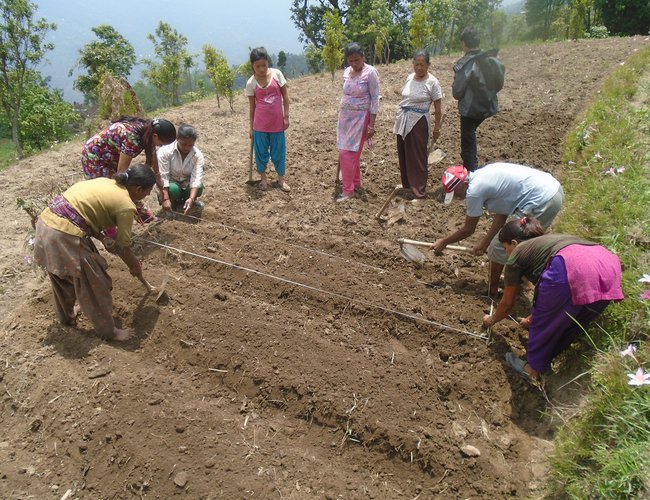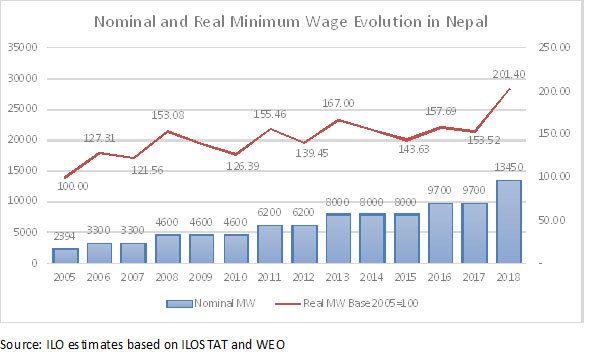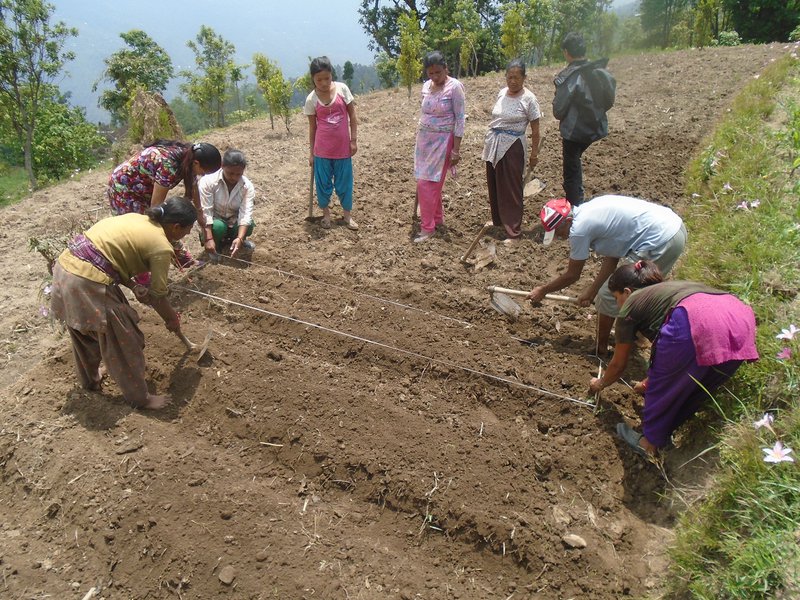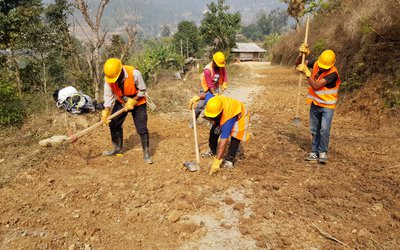
In the South Asian context, Bangladesh and Sri Lanka minimum wages have been rising in recent years, though the frequency of adjustment varies (ILO, 2018). In November 2018, the government of Bangladesh announced a new legal minimum wage for apparel workers1 - a first mandatory minimum wage increase since the Rana Plaza collapse of 2013. In 2016, Sri Lanka established a national minimum wage by the National Minimum Wage of Workers Act, No. 3 extending the coverage to all wage earners, except for domestic workers.
In Pakistan, since 2010 minimum wages are set at the provincial level by Minimum Wage Boards. There has been an annual revision through these tripartite bodies, which has led to an increase in the minimum wage, sometimes more influenced by the decision taken at the federal level to set the minimum wage in Islamabad Capital Territory.
According to the India Wage Report, there are more than 1,700 minimum wage rates in India for different scheduled employments, covering two-thirds of all wage earners (ILO, 2018a). Although both central and state governments set minimum wage rates based on the 1957 Indian Labour Conference and 1992 Supreme Court Judgement guidelines, complexities arise from the lack of uniform criteria, wide range of levels and uneven periodicity of revision.
Actions carried out by South Asian countries improving minimum wage setting in a balanced approach and extending the coverage to more wage workers is now on the agenda for the region. Nepal, a country that has ratified 11 ILO Conventions including the Minimum Wage Fixing Convention 131, (1970) is also shaping its minimum wage system as the Labour Act, 2074 has replaced the previous labour law.
Nepal Minimum Wage System
On August 2018, ITC-Turin, ILO and the V.V. Giri NLI conducted a Regional Training Course on “Designing and Implementing Effective Wage Policies” in New Delhi – India. Nepali representatives concluded that tripartite social dialogue and regular minimum wage revisions are positive characteristics of their minimum wage system, but they also mentioned that a “scientific” minimum wage fixing mechanism based on evidence could improve the way minimum wages are set in the country.
Regarding the challenges Nepal has towards designing and implementing effective wage policy, four major areas were mentioned: the establishment of a permanent minimum wage fixation committee, inter-government coordination, evidence-based generation and enhancing the productivity of Nepalese enterprises. Finally, the major constraint that they encountered for effective application of the minimum wage was the weak inspection and enforcement accountable by the Labour and Employment offices.
The minimum wage system has its challenges and opportunities. Now the Minimum Wage Fixation Committee, constituted by the Ministry shall have a permanent status which shall recommend a national minimum wage or a minimum wage for a particular region or industry. The use of evidence-based information and studies can provide an adequate approach to arrive at the appropriate minimum wage level. With evidence to support the deliberations of both workers’ and employers’ organizations, the discussion narrows down to a range of values and views essential to develop a consensus.
A particular strength in the Nepal minimum wage system today is bolstered on a tripartite and social dialogue that has regularly revised minimum wages every two years. In 2018, Nepal, a tripartite consultation decided to increase its minimum wage to NPR 13,450 a month (Figure 1), a 39 per cent increase since last revision and since 2005 the purchasing capacity of wage workers has doubled. Similarly, the daily minimum wage increased to NPR 517, and the hourly minimum wage increased to NPR 69. On the other hand, a differentiated minimum wage of NPR 10,781.00 was established for the tea estate (“Minimum Wage Tea Estate “)
Figure1: Nominal and Real Minimum Wage Evolution in Nepal

In the new context, as the labour act does not differentiate workers between the informal and formal economy, the application of the minimum wage remains a challenge. According to ILO, 67.9 per cent of all Nepali employees is in the informal employment category (ILO, 2018c). The steps to extend the coverage to all groups of wage earners is in line with Convention No. 131, and as a result, the scope of application of minimum wage has expanded tremendously
Minimum wage implementation
The effective implementation of the minimum wage requires the commitment, coordination and effort of all stakeholders. Eventually, the outcome of an effective implementation depends on whether workers receive minimum wages or not.
The Minimum Wage Fixing Convention, 1970 (No. 131) highlights that “Appropriate measures, such as adequate inspection reinforced by other necessary measures, shall be taken to ensure the effective application of all provisions relating to minimum wages”. Additionally, Recommendation No. 135 provides specific measures to help address the enforcement of minimum wage provisions.

The most significant change that has occurred in the Nepal minimum wage system is the extension towards a universal coverage. In some countries, more than half of all wage earners who are entitled to the minimum wage are paid wages below the legal floor (Rani et al., 2013). So this signals for a more indepth analysis to address which are those workers and what are their characteristics that may still not get the minimum wage.
Measuring levels of compliance
In many countries, minimum wage boards or departments of labour coordinate with national statistical institutions to have first-hand access to statistical data. The primary sources are used to estimate the percentage of workers earning less than the legal minimum wage in different occupations and sectors.
An analysis of the level and distribution of wages across geographical areas, industries, formal and informal sectors, and type of employment status using the latest available labour force survey can provide a first glance of what can be the level of compliance to the new minimum wage.
Another way to measure non-compliance is through the use minimum wage violations detected through labour inspections. However, the use of labour inspection assessment provides only a partial and limited view regarding the inspected sectors or areas.
Transitional arrangements
In South Africa, for example, as the national minimum wage was introduced to cover the left-out 60 per cent of wage earners, some transitional arrangements were introduced to progressively improve the levels of compliance. These arrangements ensured that specific sectors and firms had the sufficient time to adjust to the national minimum wage. Farm and forestry sectors, as well as domestic workers, were given one more year to adapt to the new coverage. The South African Advisory Panel acknowledged that these sectors were the most vulnerable to disemployment and as often poorly organised, which made them especially vulnerable. Small businesses (employing fewer than ten people) were given 18 months to adjust to the new minimum wage level. Therefore enforcement of minimum wages focused on an extensive public campaign and training programme; where compliance be achieved through technical assistance and persuasion; and no sanctions to be set in the first two years. In fact, on the two year period, a process of monitoring had been suggested to look into the effects of the new minimum wage, including the level of compliance.
Information and awareness raising campaigns
Awareness raising campaigns constitute an important factor as a deterrent to non-compliance. It is, therefore, necessary to work on a systematic approach to disseminate the minimum wage information including relevant provisions such as rates, coverage, sanctions and penalties, claim channels, employer’s and workers’ organization focal points, and other elements that may improve enforcement. In countries like Tunisia, government makes a press releases to publicise minimum wage rates which are broadcasted both on television and radio at a national and regional level (ILO, 2014). Most countries use their official websites2 to promote and disseminate information on minimum wages and related legal provisions.
In many countries, campaigns have included an approach building a culture of compliance focusing on the positive impacts the minimum wage will have in the country. In Costa Rica, a minimum wage campaign led to substantial increases in the wages of women, younger workers and less-educated workers (Gindling et al. 2014). The campaign called “Comply and Win” contributed to raise awareness of the importance of the minimum wage and raised the level of consciousness among employers and workers to comply with the law3 .
Information dissemination strategies are essential to expanding the outreach of minimum wage rates and other provisions necessary for enhancing their enforcement. The use of local languages and appropriate channels of information including the Internet, television and radio broadcasts are likely to increase the coverage. In Ecuador, the 2011 campaign for the “Salario Digno” portrayed real- life short films stories which helped disseminate the new national minimum wage rate and provided examples on how purchasing power had increased the capacity of the worker and his family accessing higher standards of living.
Streamlining minimum wage information can potentially improve compliance even in the informal economy. Some studies provide evidence that minimum wages become wage fixing benchmarks for workers in small or informal enterprises commonly not inspected; the effect is known as a lighthouse effect
The role of employers’ and workers’ organizations
Full consultation with social partners is one of the pillars of ILO’s Convention No.131. The design of an effective Tea workers at tea garden in Ilam minimum wage system includes determining the minimum wage level and structure which involves consulting with both employers’ and workers’ organizations. The process of consultation also looks into the establishment and operation of the minimum wage system, which includes measures to facilitate and encourage compliance as well as to address the problems encountered in the enforcement of minimum wage legislation.
Both workers’ and employers’ organizations can help disseminate information on minimum wages to their members. Both organizations can also support departments of labour and minimum wage boards to identify causes of non-compliance and to can help conduct workshops or training activities to ensure the enhancement of compliance through awareness raising.
Another essential feature to improve minimum wage enforcement is the empowerment of workers to claim their rights. The claim can be made through individual action as well as a collective action. In some countries, active participation of workers’ and employers’ organizations with labour departments or labour inspectors can result in better enforcement outcomes. For example, in India trade unions may represent a worker’s claim in court.
Inspection system
An appropriate inspection system requires a legislative framework that defines labour inspectors’ functions and scope of action (Marinakis et al., 2014). Available human resources and technical capacity should be suitable to inspect and to assess if there is a violation of any minimum wage provision and to notify or sanction the violator of the law. A focus on proactive actions is recommended, based on strategic planning, and a system with adequate and dissuasive sanctions. All those components will play a critical role in enforcing minimum wage provisions.
Although an inspector’s role consists of adequate supervision of labour rights including minimum wages; in some countries, inspectors use preventive measures such as advising and training with a more holistic approach.
Strategic planning programs, prioritizing sectors, geographical areas and types of enterprises prove to be more productive. Subsequently, technological tools such as integrated platforms or even mobile devices with GPS applications can enhance the effectiveness of inspections, optimizing resources and becoming more assertive as new inspections plans are developed focusing on those non-complaint sectors or recidivist enterprises.
Sri Lanka, for example, has developed a “Labour Inspection System Application (LISA)” (ILO, 2018b). The system supports the use of a tablet for labour inspection. The inspector registers the information in the tablet and uploads the filed case on LISA. The process helps to monitor inspections, ensuring compliance, and following up on the claims, simplifying the work at the Complaint and Legal Department.
Formalizing the informal economy

ILO Recommendation No. 204 concerning the Transition from the Informal to the Formal Economy provides guidance to facilitate the transition of workers and economic units to the formal economy while ensuring the preservation and improvement of existing livelihoods during the transition.
For Nepal it becomes essential to address some of the provisions under this Recommendation to design coherent and integrated strategies to facilitate the transition from the informal to the formal economy.
According to the 2017 labour force data the majority of workers in informal employment ( 6 8 . 3 p e r cent) work in informal sector enterprises calling for measures to formalize enterprises together with measures to formalize jobs. This will demand tailored approaches to respond to the diversity of these situations found in the Nepali context. The Recommendation also calls for a combination of incentives, compliance and enforcement measures.
A way forward for improving the minimum wage system in Nepal
The new labour law sets two significant challenges for the minimum wage system in Nepal. On the one hand, to establish a permanent Minimum Wage Fixation Committee for setting minimum wages with the use of evidence-based information to balance both the needs of workers and their families and economic factors. On the other hand, as the new law extends the scope to cover all workers, the application of the minimum wage should ensure progressive compliance to protect all workers and enable the development of sustainable enterprises.
Evidence-Based Social Dialogue: Tripartite social dialogue in Nepal is a valuable asset that can be decisive for the operationalisation of an effective minimum wage system. On the basis of dialogue priorities must be set forward to strengthen the permanent Minimum Wage Fixation Committee, to enhance its technical capacity for the recollection of data and information to work towards a more “scientific” approach taking into account the needs of the workers and their families and economic factors based on evidence to revise and set minimum wages; and to design a minimum wage system that enforces minimum wage provisions effectively. Also important would be to establish measures to follow-up or monitor the effects on wages and employment.
Finally, social dialogue has to take place through coordination and cooperation among local governments, to consolidate the federal system now in place.
Compliance: Building enforcement capacities, taking into account international experiences to improve minimum wage enforcement and encouraging formalisation of enterprises will aid this process of greater compliance. A well designed minimum wage system is not limited to set the minimum wage rate but it should also consider measures to monitor the level of compliance and to strengthen the enforcement machinery.
Nepal has an enormous opportunity to benefit workers through its new labour law. Establishing an effective minimum wage system will have beneficial impact on multiple dimensions. It is therefore essential for stakeholders to take progressive measures based on a proper assessment of the labour market using the latest labour force survey to increase the effectiveness of its minimum wage policy.

















